
Monmouth is a town and community in Wales. It is situated where the River Monnow joins the River Wye, 2 miles (3.2 km) from the Wales–England border. Monmouth is 30 miles (48 km) northeast of Cardiff, and 113 miles (182 km) west of London. It is within the Monmouthshire local authority, and the parliamentary constituency of Monmouth. The population in the 2011 census was 10,508, rising from 8,877 in 2001. Monmouth is the historic county town of Monmouthshire although Abergavenny is now the county town.

Monnow Bridge, in Monmouth, Wales, is the only remaining fortified river bridge in Great Britain with its gate tower standing on the bridge. Such bridge towers were common across Europe from medieval times, but many were destroyed due to urban expansion, diminishing defensive requirements and the increasing demands of traffic and trade. The historical and architectural importance of the bridge and its rarity are reflected in its status as a scheduled monument and a Grade I listed building. The bridge crosses the River Monnow 500 metres (1,600 ft) above its confluence with the River Wye.

Monmouth School for Boys is a public school for boys in Monmouth, Wales. The school was founded in 1614 with a bequest from William Jones, a successful merchant and trader. The School is run as a trust, the William Jones's Schools Foundation, by the Worshipful Company of Haberdashers, one of the livery companies, and has close links to its sister school, Haberdashers' Monmouth School for Girls. In 2018, the Haberdashers renamed their group of schools in the town, the Monmouth Schools, and made corresponding changes to the names of the boys' and girls' schools.

The Shire Hall in Agincourt Square, Monmouth, Wales, is a prominent Grade I listed building in the town centre. It was built in 1724, and was formerly the centre for the Assize Courts and Quarter Sessions for Monmouthshire. In 1839–40, the court was the location of the trial of the Chartist leader John Frost and others for high treason for their part in the Newport Rising. The building was also used as a market place. The Shire Hall is owned by Monmouthshire County Council and has audiovisual guides for visitors to Courtroom 1. It is currently used as a Tourist Information Centre and as the offices for Monmouth Town Council, and is open to the public in part.
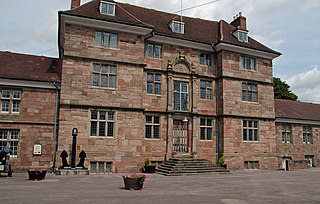
Great Castle House is a former town house built on the site of part of Monmouth Castle in Wales. Amongst the town's most significant buildings, it has a Grade I listing and is one of 24 sites on the Monmouth Heritage Trail. The house is located on Castle Hill, off Agincourt Square in Monmouth town centre.
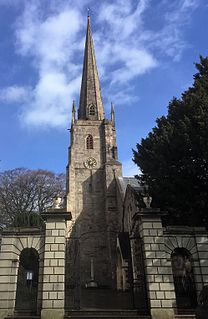
St Mary's Priory Church, in Whitecross Street, Monmouth, Monmouthshire, Wales, is an Anglican church founded as a Benedictine priory in 1075. The current church dates mostly from the 18th and 19th centuries. It was designated a Grade II* listed building in 1952. It is one of 24 buildings on the Monmouth Heritage Trail.

Monmouth Priory, in Priory Street, Monmouth, Wales, is a building that incorporates the remains of the monastic buildings attached to St Mary's Priory Church. The priory was a Benedictine foundation of 1075, and parts of the mediaeval buildings remain. The buildings were substantially redeveloped in the nineteenth century for use as St Mary's National School, and now form a community centre. The complex is a Grade II* listed building as of 27 June 1952. It is one of 24 sites on the Monmouth Heritage Trail.

The Monmouthshire Beacon is a weekly tabloid newspaper covering the areas of Monmouthshire, south Herefordshire and western Gloucestershire. It has been in continuous publication since 1837. Since 1980 the newspaper has been part of the Tindle Newspaper Group of local newspapers owned by Farnham Castle Newspapers and chaired by Sir Ray Tindle (1926-2022).
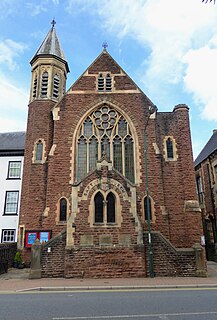
Monmouth Baptist Church is located in Monk Street, Monmouth, south east Wales. The church building was opened in 1907, although the Baptist congregation had been formed in 1818. The church became a Grade II listed building on 27 October 1998.
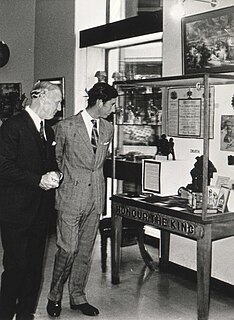
Keith Edward Kissack MBE was a British schoolteacher and historian. He is notable for his many publications on the history of Monmouth and Monmouthshire.

The Old Nag's Head, Old Dixton Road, Monmouth, Wales, is a nineteenth-century public house, with medieval origins, which incorporates a "stone drum tower of the town defences constructed between 1297 and c.1315." The tower is the only "upstanding remains of the town walls of Monmouth." The pub was designated a Grade II* listed building on 26 April 1955, its rating being due to "its interest as an early C19 public house which retains its character as well as a significant portion of a medieval gate-tower."

Church Street is a pedestrianised street in the centre of Monmouth, Wales. It contains a variety of independent shops, restaurants, commercial art galleries, and the Savoy Theatre. Until the 1830s, when Priory Street was built to bypass it, it was the main thoroughfare into the centre of Monmouth from the north-east, linking the market and the parish church. It was at one time the centre of the town's butchery trade and was known as Butcher's Row.

Overmonnow is that part of the town of Monmouth, in Wales, which is located to the west of the River Monnow and the Monnow Bridge. It developed as a suburb of the town in the Middle Ages, when it was protected by a defensive ditch, the Clawdd-du or "Black Dyke", the remains of which are now protected as an ancient monument. In later centuries the area became known as "Little Monmouth" or "Cappers' Town". Development of the area has continued, particularly since the mid-twentieth century, and the area is now a ward of Monmouthshire County Council.

Monmouth Poor Law Union was formed on 11 July 1836 in Monmouth, Wales

North Parade House, in Monmouth Wales, dates from the late 18th century, and was refurbished in c.1800 by a wool merchant who took over the malthouse next door as a wool store, along with the cottages further up the street as housing for his workers. It has been a grade II listed building since 27 October 1965.
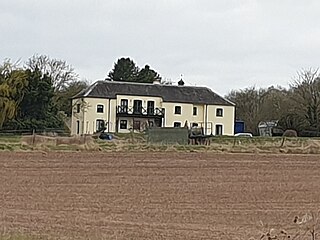
Croft-Y-Bwla is a country house and farm 1.5 miles (2.4 km) north-west of Monmouth, south-east Wales. The house was built around 1830 and was designed by the noted Monmouth architect George Vaughan Maddox. It has been listed as Grade II since 1974.
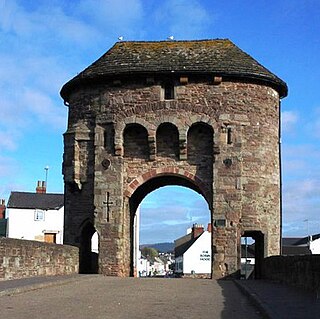
The Monmouth town walls and defences comprise the defensive system of town walls and gates built in Monmouth, Wales between 1297 and the early part of the following century. Wye Bridge Gate, East Gate, Monk's Gate, and Monnow Bridge Gate were access points to the town. West Gate, across Monnow Street, also provided access. Only the Monnow Bridge Gatehouse survives intact, albeit in a substantially modified version from the original.

Monk Street is an historic street in the town of Monmouth, Monmouthshire, Wales. A portion of it was in existence by the 14th century, and appears on the 1610 map of the town by cartographer John Speed. It runs in a north-south direction, extending northward from its intersection with Whitecross Street. The name of the street relates to the nearby Priory, as well as the gate which was originally on this road and provided part of the town's defences, Monk's Gate. Monk Street is lined with numerous listed buildings.

1–6 Priory Street in Monmouth, Wales, is a row of six shop houses designed by the architect George Vaughan Maddox and constructed c. 1837. They form part of Maddox's redevelopment of the centre of Monmouth and stand opposite his Market Hall. The architectural historian John Newman has written that Maddox's work "gives Monmouth its particular architectural flavour," and considers Priory Street to be "his greatest work."

Royal George House in Monmouth, Wales, is a large Georgian townhouse of c. 1730. Its architectural style is "old-fashioned" for its date, drawing on Carolean models such as Tredegar House. Built as a private residence, in 1800 it was occupied by the commander of the Monmouthshire Militia. In the 19th and 20th centuries the building was a hotel, first the Ivy Bank and then the Royal George. By the 1980s, it was empty and derelict. Restored, and significantly altered internally, in 1985–1987, it was subsequently a nursing home, and as of 2017 it houses commercial offices and residential apartments. It is a Grade II* listed building.






















